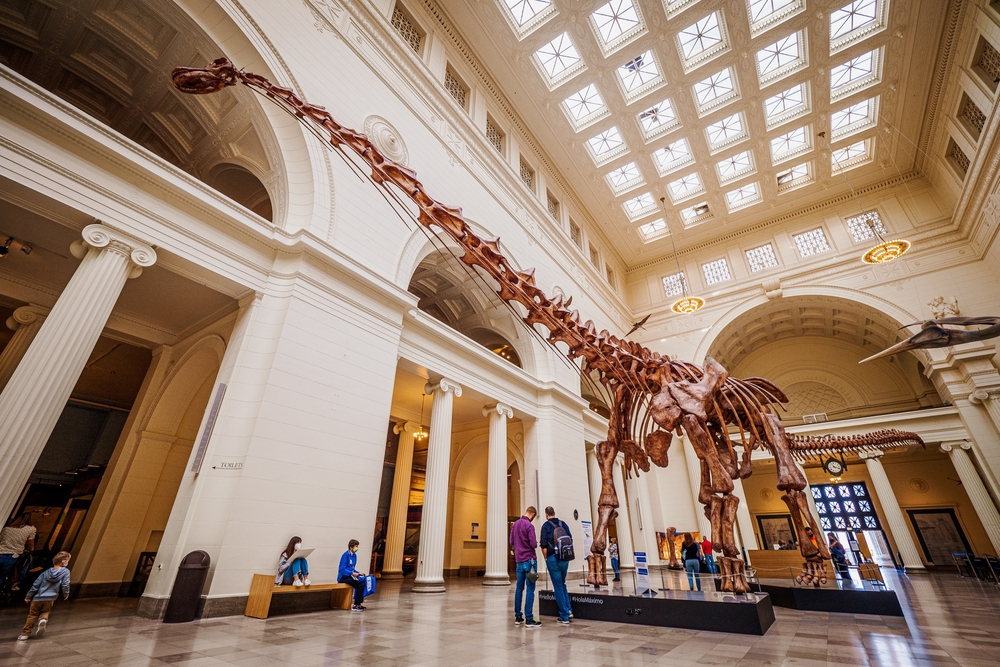5 Massive Dinosaur Fossils and Where They Were Found
Posted on Categories Discover Magazine

In 1842, the term “Dinosauria” (which translates to “terrible lizard”) was coined by British anatomist and paleontologist Sir Richard Owens. The Megalosaurus was the first dinosaur described in scientific literature based on a jaw fragment. In the almost 200 years since then, approximately 11,000 dinosaur fossils have been discovered.
Dinosaurs existed during the Mesozoic Era, approximately 250 million years ago. This time included the Triassic, Jurassic, and Cretaceous periods. With more than 700 species of dinosaurs having been identified to date, scientists are still uncovering new evidence. Let’s take a look at where some of the largest dinosaur fossils were discovered.
1. Patagotitan mayorum
(Credit:schusterbauer.com/Shutterstock)
Patagonia, Argentina 2012 — Weighing the equivalent of 10 African elephants, Patagotitan mayorum, the 70-ton Titanosaur, is believed to be the largest dinosaur ever to live. In 2012, a worker was managing the sheep at La Flecha ranch in Patagonia — when he discovered fossils. The ranch’s owner suspected they were dinosaur bones and contacted paleontologists.
Researchers spent one and a half years excavating the area. In total, they collected more than 200 fossilized bones, including a femur and significant sections of a spine. The fossils came from at least six dinosaurs, all of which were Titanosaurs, a new genus of sauropod. The Titanosaur reached 40 feet tall, had a long neck and lived over 95 million years ago during the late Cretaceous period.
Read More: Have Scientists Found the Biggest Dinosaur?
2. Brachiosaurid sauropod
(Credit: Instituto Dom Luiz (Faculty of Sciences of the University of Lisbon) (Portugal).
Pombal, Portugal 2022 — As he was getting ready to start renovations in his backyard, a man in Portugal discovered pieces of fossilized bone. He contacted scientists at the University of Lisbon, who began excavating. They found ribs 10 feet long and a spine belonging to a brachiosaurid.
The size of the fossils led researchers to conclude this dinosaur may have been 40 feet tall and 80 feet long. It is believed that this discovery was the largest dinosaur ever unearthed in Europe. What makes this finding even more impressive is the layout of the vertebrae and ribs. According to Dr. Elisabete Malafaia, a postdoctoral researcher at the University of Lisbon, “It is not usual to find all the ribs of an animal like this, let alone in this position, maintaining their original anatomical position.”
3. Australotitan cooperensis
Southwest Queensland, Australia — For 17 years, scientists (including paleontologists, geologists and fossil preparators) have worked on a project involving a unique type of titanosaurus. Named Australotitan cooperensis, in honor of its discovery location, it’s considered the largest animal ever to walk the Outback.
Australotitan lived between 92 and 96 million years ago — when Queensland was still attached to Antarctica. As long as a basketball court, Australotitan was unique and much larger than other dinosaurs living in Australia during the Cretaceous Period. It is among the 15 biggest dinosaur specimens in the world. Over the last few decades, Queensland has emerged as a leading dinosaur fossil exploration and discovery location.
4. Maip macrothorax
(Credit: Agustín Ozán/CONICET)
Patagonia, Argentina (2019) — Since Patagonia was home to many dinosaur species, it’s no surprise that there was another notable fossil discovery there. This one occurred in 2019 when scientists identified a new species of giant raptor, Maip macrothorax. This raptor would have stood about 30 feet tall and weighed five tons.
One of the last dinosaurs to exist, they lived in Argentina’s forests 70 million years ago. It was a top predator, able to prey on smaller dinosaurs thanks to its long talons and sharp claws. Like other raptors in the Megaraptors group, M. macrothorax had long legs and semi-hollow bones that made them fast runners.
5. Triceratops horridus
South Dakota, USA 2014 — the Triceratops horridus, known as “Big John,” was sold for almost $8 million at auction in 2021. Discovered by paleontologist Walter Stein, the fossil was named for the ranch owner where it was discovered. When found, Big John’s skeleton was 60 percent complete, including a skull that was 75 percent complete.
The long process of excavation took almost two years. From there, it was on to Italy, where the fossil was restored. Beginning in 2023, the Pagidipati family (owners of Big John) lent the fossil to the Glazer Children’s Museum in Tampa, Florida, for a three-year exhibition.
Read More: 5 Facts About Triceratops Horridus